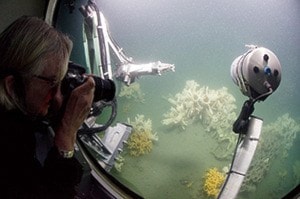The ‘Sea of Glass’ could soon shatter permanently if areas off Prince Rupert’s Pacific coast are not properly protected, Alexandra Barron, marine conservation coordinator at the Canadian Parks and Wilderness Society (CPAWS) said.
“[The Hecate Strait glass sponge reefs] have only been found in B.C., they are not found anywhere else in the world. It took a while for scientists to realize how significant this discovery really was but we’ve been working since 2001 to protect them,” Barron said.
Glass Sponge Reefs, also known as the ‘Sea of Glass’, are found in water depths ranging from 140 to 240 metres and have been discovered off the west coast between Haida Gwaii and the mainland of British Columbia. These fragile reefs are an important habitat for a number of deep-sea species such as rock fish, prawns, octopus and sharks to name a few. They also work to clean the ocean filtering the equivalent of one Olympics-sized swimming pool every 40-70 seconds removing 90 per cent of the bacteria.
“They feel like dried meringue so they are fragile and smash apart easily. Even a net in the water not meant to reach the sea bed … can still sometimes [damage them],” Barron said.
The Department of Fisheries and Oceans Canada (DFO) have now designated a Marine Protected Area (MPA) under the Oceans Act to conserve and protect these globally unique reefs. The draft Hecate Strait MPA regulations were posted June 27 to the Canada Gazette giving Canadians 30 days (until July 27) to influence the protection of the prehistoric species.
While CPAWS is pleased about the MPA, they are disappointed that regulations will still allow fishing activities around and above the reefs including bottom trawl, mid-water trawl and prawn and crab trap fisheries.
The 9,000-year-old reefs were thought to have been extinct for more than 40 million years until they were discovered in 1987.
Scientists estimate about 50 per cent of the reef has already been destroyed due to bottom trawling. As filter feeders, the reefs are also at risk of being smothered by sediments when the ocean floor is stirred up by fishing, Barron said.
“We are asking people to let Fisheries of Canada know we need the MPS to be put in place and for it to happen quickly. We need to make sure the regulations are strong so that they protect the reefs from all threats and at the moment they just don’t do that.”
